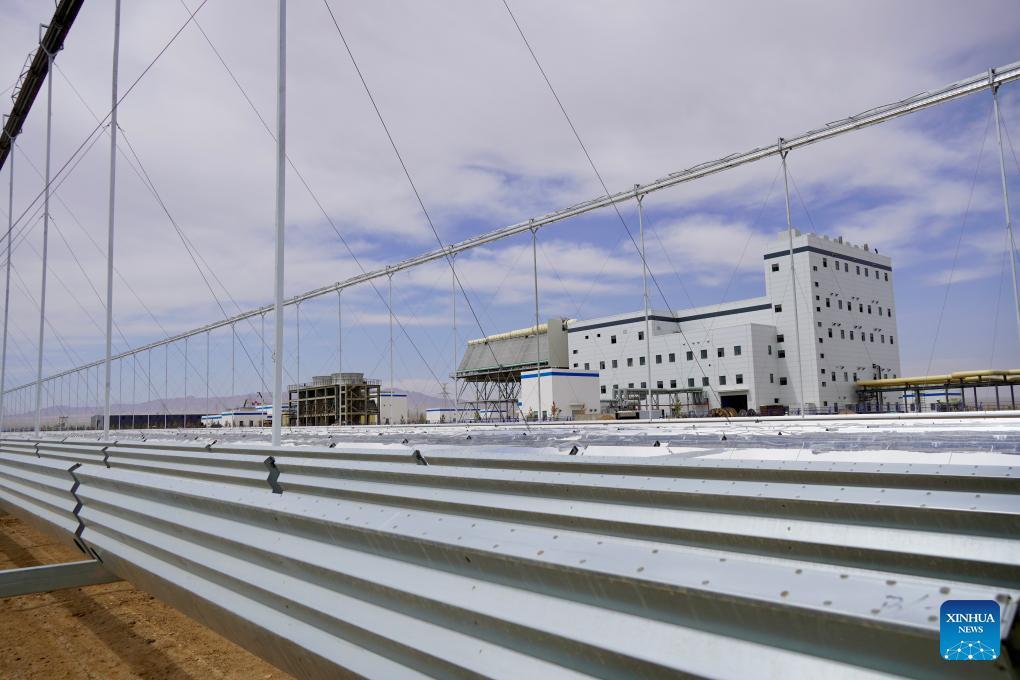NW China's resource-depleted city revitalized by green power
Xinhua | July 17, 2024

This photo taken on July 1, 2024 shows a concentrated solar thermal project in Yumen City, northwest China's Gansu Province. (Xinhua/Cao Peixian)
On the edge of the sprawling Gobi Desert lies the Chinese city of Yumen, a place that has worn many faces over the decades.
Once hailed as the "cradle of China's oil industry," it later made headlines as a "ghost town." Today, Yumen is reinventing itself as a green energy powerhouse, with arrays of glistening solar panels and towering wind turbines dominating its vast desert landscape.
Yumen, a county-level city in northwest China's Gansu Province, was one of 69 resource-depleted areas striving to rejuvenate amidst the country's shift towards green development.
FROM BOOMING TO FORGOTTEN
In its heyday, Yumen pulsed with the rhythm of oil pumps. Lifelong resident Ma Jinyue, 57, recalls a time when Yumen was the envy of the region. "We Yumen folks were among the first in China to live in modern apartments and enjoy Hollywood flicks at the local cinema," Ma said.
In 1957, China's first petroleum industrial base was established in Yumen, which is home to the country's first oil well drilled in 1939. At its peak, the Yumen oilfield produced around 90 percent of China's total oil output. The city also nurtured the country's first generation of oil experts, who later spearheaded efforts at other petroleum bases.
However, by the late 1990s, Yumen's oil reserves were rapidly depleting. Although Yumen's oil production never came to a complete halt, many businesses closed, government agencies relocated, and people moved away. Ma was among those who stayed, witnessing his hometown's decline.
"The Yumen you'll find on maps now is the new city, 70 km west of the old one where I live," he said.
The old city, once home to over 130,000 people in the 1980s, now houses fewer than 20,000 residents. Its dilapidated Soviet-style buildings stand as weathered sentinels of a bygone era, earning Yumen the label of a "ghost town."
HARNESSING GREEN POWER
Despite all the setbacks, Yumen is rising anew. In 2009, after the city was designated a resource-depleted area, it broke ground on China's first 10-million-kilowatt wind power base.
Cradled between two mountain ranges, Yumen boasts rich wind and solar resources and vast tracts of land available for energy development. The average wind speed at 70 meters height reaches 7.9 meters per second. The city also enjoys over 3,300 hours of sunshine annually.
As a tactical shift in 1997, Yumen established one of China's earliest wind farms -- the first in Gansu -- amid China's push for renewable energy.
Since then, the city has quickly expanded its green energy portfolio and now hosts facilities for wind power, photovoltaics, concentrated solar thermal, and hydrogen production.
At the site of one of Yumen's largest new energy power projects, workers are in the final stretch to complete a section of the solar thermal power plant by the year's end. This project features wind power, photovoltaic, and concentrated solar thermal systems.
Once fully operational, the project will generate 1.76 billion kilowatt-hours of power annually, reducing carbon dioxide emissions by 1.35 million tonnes, explained Zhu Yi, operation manager of the project.
It is equivalent to the emissions from around 700,000 long-haul flights of 10,000 km each, Zhu said.
At present, Yumen not only meets its local power demand but also collaborates with other new energy bases in Gansu to provide green electricity to 25 provincial-level regions across China, according to State Grid Gansu Electric Power Co., Ltd.
BEYOND ENERGY
Yumen's resurgence goes beyond energy production. It has evolved into a hub for manufacturing new energy equipment, with 13 projects driving its economy. In 2023, the total output value of this industry reached 3.7 billion yuan (about 518.73 million U.S. dollars).
According to Zhu, all equipment used in his project is domestically produced, with many items manufactured locally in Yumen.
The old oil city has also found new life through the expansion of the petrochemical industry chain. In August 2023, a large-scale hydrogen production project was launched in old Yumen, followed by the inauguration of a new materials project earlier this year.
As Yumen strides into its green future, it continues to honor its industrial heritage. A national scenic spot has been established to preserve its historical sites. Excavators and bulldozers can be seen on the streets of the old city for infrastructure upgrades, with the government investing nearly 400 million yuan since 2016.
Chen Yuhong, a local resident who returned to old Yumen after two decades away, recently accompanied her friends from outside Gansu to visit a preserved nodding donkey oil pump, marking the site of China's first oil well. "I wish people could see both our past and our promising future," she said.

